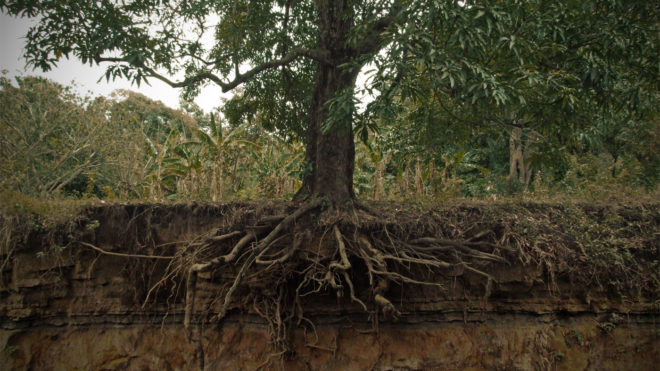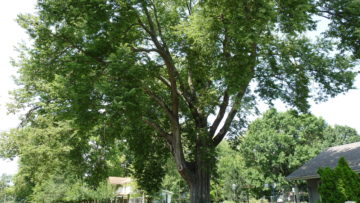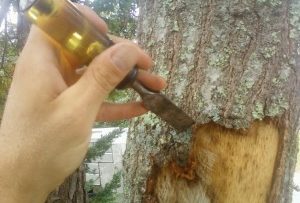 Okay, So here’s the bottom line. Do you want the trees that you’ve planted to be healthy and live a long, fruitful life? Then you need to be thinking about the parts of the tree that, for the most part, go unnoticed. THE ROOTS! Healthy roots = healthy trees.
Okay, So here’s the bottom line. Do you want the trees that you’ve planted to be healthy and live a long, fruitful life? Then you need to be thinking about the parts of the tree that, for the most part, go unnoticed. THE ROOTS! Healthy roots = healthy trees.
Now we could get in to the biology and physiology of trees roots, and while some may find that quite interesting, this post would become WAY too long. No, today we are talking about the basics. The tree knows how to do all of that physiological stuff on its own. All you need to do is give the tree what it needs to do it.
4 Simple things that you can provide for your tree’s proper root health
1.Well, first of all your tree’s roots need soil to grow in. I know that sound like stating the obvious but to really provide your tree with the soil volume it needs as it grows may take some planning. The root zone of a fully grown tree will stretch out far beyond the drip line of the tree’s canopy. In our last You can Grow That post, I wrote a little bit about plant location and giving room for your tree to grow. This applies to the roots as well. Unless your growing Bonsai, trees don’t do well in containers, Give ’em room for their roots to stretch out and do their thing.
 The first way that you will meet this need for your tree is to dig the planting hole 3 times the size of the root ball so new roots can grow into the loosened soil easily. To back fill the planting simply use existing soil to fill around the tree’s roots. there is usually no need to amend the soil since the young tree must adapt to the soil in your yard to thrive. If your soil has a lot of clay, add at most 25 percent organic compost.
The first way that you will meet this need for your tree is to dig the planting hole 3 times the size of the root ball so new roots can grow into the loosened soil easily. To back fill the planting simply use existing soil to fill around the tree’s roots. there is usually no need to amend the soil since the young tree must adapt to the soil in your yard to thrive. If your soil has a lot of clay, add at most 25 percent organic compost.
2. The next thing that you need to provide for you tree roots is oxygen. Yes that’s right, tree roots need oxygen. Now you might be thinking, “nature already freely provides all of the oxygen that we could want” ( ironically by means of all of the trees ). And that’s true, but what we can do to make sure that our tree’s root have the oxygen that they need is to prevent soil compaction. Soil compaction kills trees. Never plant a tree where it will experience heavy foot traffic or vehicle traffic of any kind over it’s root zone.
3. Next you need to provide a layer of mulch for the tree’s roots. The value of mulch for a tree can not be underestimated. Mulch conserves soil moister, reduces soil erosion, reduces soil compaction, regulates soil temperature, etc. etc. All of these functions are of great importance to root health. Perhaps the greatest benefit of organic mulch is the improved soil structure and nutrition through decomposition. Now it is very important to note that you should never over mulch your tree. A good 3-4 inch layer should do just fine. I know that you are probably trying to grow a few other plants in your yard but the larger the mulched area under your tree can be the better. In fact maybe you should just eliminate the lawn all together.( but I suppose that is for another post) And NEVER EVER pile mulch up on the stem of your tree. This will promote disease and fungal rot of the trunk.
4. One more very important element that you can provide for you tree’s root health is biology. Did you know that in just 1 cubic inch of healthy forest soil there are over 2 billion micro organisms? Good soil is teaming with life. This microbiology is what is responsible for the decomposition of debris and leaf liter in the forest. There are hundreds of thousands of species of microbes that are busy breaking down all of the organic matter in the soil into the nutrients that are vital for plant growth.

Most tree species are greatly benefited by the presence of mycorrhizae. Mycorrhizae are specific fungi which form a symbiotic relationship with a tree. These fungi receive their nutrition from the host plant to complete their life cycle and aid the host plant by increasing the efficiency of the tree’s root system. There are more than 2500 different fungi which may form mycorrhizal relationships with trees; often there are several different fungi associated with an individual tree. These various beneficial fungi can be applied to your soil in what is known as biofertilizers. These biofertilizers should be available in any local lawn and garden center.
Rather than applying conventional chemical ( or even organic) fertilizers, these biofertilizers work with the tree roots and your nicely applied organic mulch to provide nutrients for the tree in much the same way that the forest floor does.




